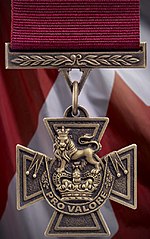Victoria Cross (Canada)
| Victoria Cross | |
|---|---|

The Canadian Victoria Cross, as appearing in a promotional photograph from the Canadian government, May 2008.
|
|
| Awarded by the monarch of Canada |
|
| Type | Medal |
| Eligibility | Members of the Canadian Forces or an allied force serving with the Canadian Forces on or after 1 January 1993. |
| Awarded for | The most conspicuous bravery, daring or pre-eminent acts of valour, self-sacrifice, or extreme devotion to duty in the presence of the enemy. |
| Status | Currently awarded |
| Post-nominals | VC |
| Statistics | |
| Established | 2 February 1993 |
| Total awarded | 0 |
| Precedence | |
| Next (lower) | Cross of Valour |
|
Ribbon bar for the Victoria Cross |
|
The Victoria Cross (French: Croix de Victoria), created in 1993, is a military decoration and the highest award within the Canadian honours system, taking precedence over all other orders, decorations, and medals. It is awarded by either the Canadian monarch or his or her viceregal representative, the Governor General of Canada, to any member of the Canadian Forces or allies serving under or with Canadian military command for extraordinary valour and devotion to duty while facing hostile forces. Whereas in many other Commonwealth countries the relevant version of the Victoria Cross can only be awarded for actions against the enemy in a wartime setting, the Canadian government has a broader definition of the term enemy, and so the Victoria Cross can be awarded for action against armed mutineers, pirates, or other such hostile forces without war being officially declared. Recipients are entitled to use the post-nominal letters VC (for both English and French) and also to receive an annuity of C$3,000. The decoration has not been awarded since its inception.
The original Victoria Cross was created via a Royal Warrant issued on 29 January 1856 with the royal sign-manual of Queen Victoria, and was intended to recognize demonstrations of gallantry during the Crimean War, regardless of either a man's social status or his record of service. Initially, the Victoria Cross could not be conferred on colonial troops, until Major Charles Heaphy received the medal for his actions while serving with a New Zealand militia unit in 1864, after which the Victoria Cross was made available to all "local forces under imperial command." The cross could also not be awarded posthumously until the policy was reversed in 1902.
...
Wikipedia
